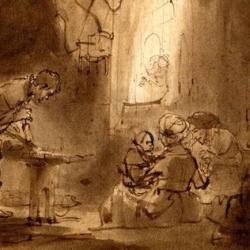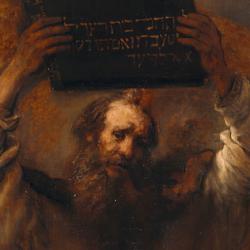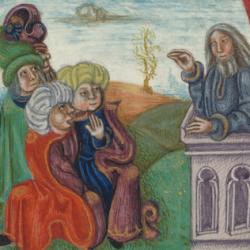I’ve been musing all day on the possibility that the somehow symbolize Israel. The Nile turns to blood because Pharaoh has been killing Hebrew babies in the river, and the frogs swarm just like the Hebrews had done (cf. Exodus 1:7).
Now I come across a 1991 article from the Union Seminary Quarterly Review by one Ari Mark Cartun that examines the numerology of the plague narrative (the limits for his purposes are 7:14-13:16). Builting on the work of Cassuto, he concludes that the names of the plagues are repeated a significant number of times throughout the narrative.
He identifies the following primary names of the plagues: “#1-Blood, 7:14-25; #2-Frogs, 7:26-8:11; #3- Kinnim (Fleas), 8:12-15; ‘arov (Ries), 8:16-28; #5- Dever (Cattle Sickness), 9:1-7; #6-Boils, 9:8-12; #7-Hail, 9:13-35; #8-Locusts, 10:1-20; #9-Darkness, 10:21-29; #10-Firstborn, 11:1-13:16.” He summarizes Cassuto’s findings:
“Cassuto noticed that the names of the plagues are repeated a curious number of times. He added up the number of times that the primary name of the first nine plagues appeared within its own narrative, and added that to the three times the word ‘crocodile’ ( tanim ) appeared in the scene in Pharaoh’s court immediately preceding the first plague (Exod 7:8-13). Finding that it totals sixty, he noted that it ‘can hardly be fortuitous.’ This Cassuto attributed to ‘a numerical schematism that finds expression in the mention of the name of a plague seven times (swarms of flies, locusts), or fourteen times (hail). The tendency towards numerical patterns based on the number seven and on the sexagesimal system is observable throughout the section.’ By concentrating on this version of ten plagues, counting from the introduction through number nine, Cassuto found a total of names of the plagues according to the pattern of triplets add up to subtotals of 24 (when the crocodiles are added in, making a ‘triplet’ of four plagues), 12, and 24. Cassuto’s full pattern reveals a sexagesimal pattern of 6×4, 6×2, and 6×4, totalling 6×10 for these ten plagues.”
Sixty is an intriguing number: It’s, of course 5 x 12. Twelve is Israel’s numbers, and when Israel leaves Egypt they go out “five in a rank,” that is, in military formation. The number 60 thus points to Israel organized as war host.
Cartun doesn’t find this persuasive, suggesting that this has no relation to the surrounding narrative. I differ. But his alternative to Cassuto’s tallies is also very intriguing. He cuts out the references to the “sea monsters” in the appearance before Pharaoh, and adds references to the firstborn, the tenth plague: “When these are added, the total number of uses of the plague names comes to 72. Cartun notes: “That there are seventy-two occurrences of primary names calls to mind both the seventy-two individuals in the list of those ‘who went down to Egypt with Jacob’ (Gen 46:8-27), and the seventy elders (e.g., Num 11:16) plus Moses and Aaron who led them out.20 These numerical concurrences embedded in the text hint at a retributive equation: the punishing of Egypt once for each one of the leaders of the nation who, symbolically representing the entirety of the Israelites, descended to and ascended from Egypt. The ten plague names which are repeated in subsequent plague narratives echo, as it were, the Ten Plagues, like the reverberations of the great blows themselves.”
Besides, the text puns on the plague names repeatedly. For instance: “To begin chronologically, the name of the fifth plague, Dever , is only used once in the fifth plague text, but puns on Dever, the words ‘speak, dabber ’ and ‘thing, davor’ appear four more times in the narrative. In the introductory formulas common to all the seven plagues preceeded by warnings (1, 2, 4, 5, 7, 8,10), ‘say to Pharaoh’ is changed here in 9:1, and only here, to read ‘speak to Pharaoh.’ In addition, the word ‘thing’ is used three times in the following three verses. Two of those times, in verses 9:5 and 6, the pun is direct, and obviously refers to the plague itself: ‘YHWH will do this ‘thing/ davar ’ tomorrow.’ The last repetition, in 9:4, is a cryptic pun: ‘not one ‘thing/davar’ shall die of all that belongs to the children of Israel.’ This last one also pointedly puns Dever , as the line could have read, ‘not one of the cattle of the Israelites, etc.’ And so, taken together, there are four plays on the name Dever . Though Cassuto recognized this wordplay, he did not count these puns as repetitions of the plague name.” There are 18 addition allusions to the plague names in the puns, bringing a total of 100 uses, 10 x the 10 plagues.
For my purposes, the interest of these numerical connections is that they support the hypothesis that the plagues are meant to represent Israel.










